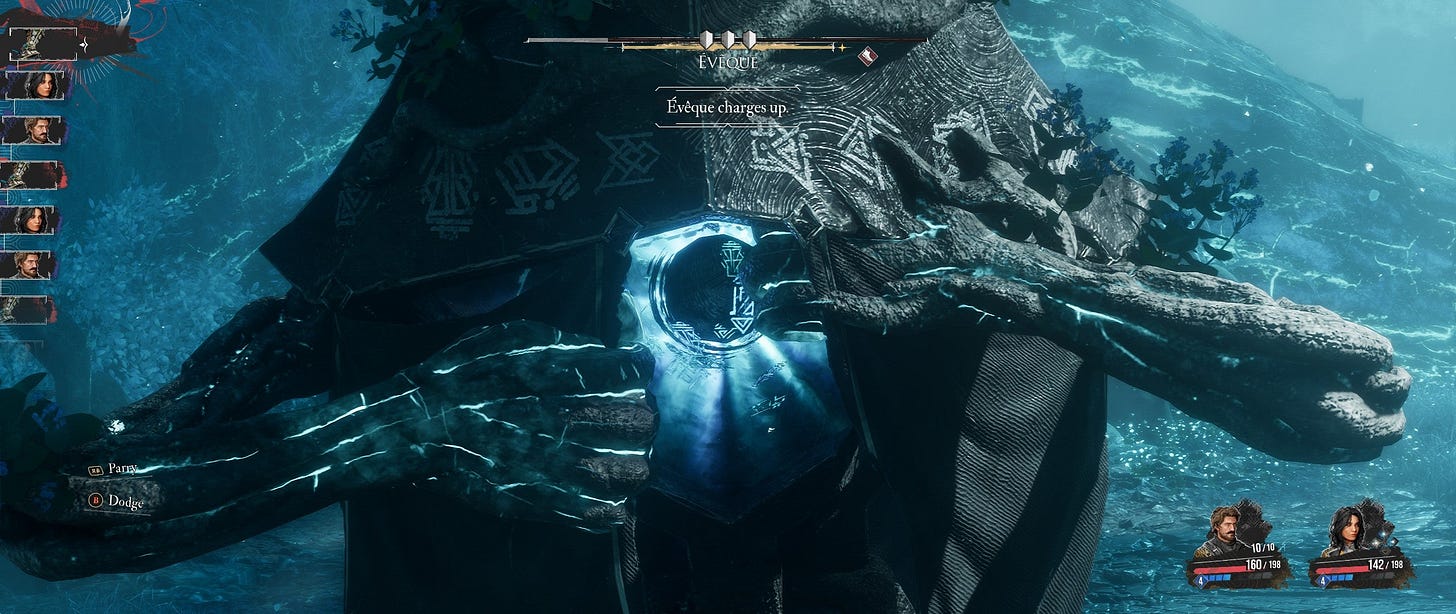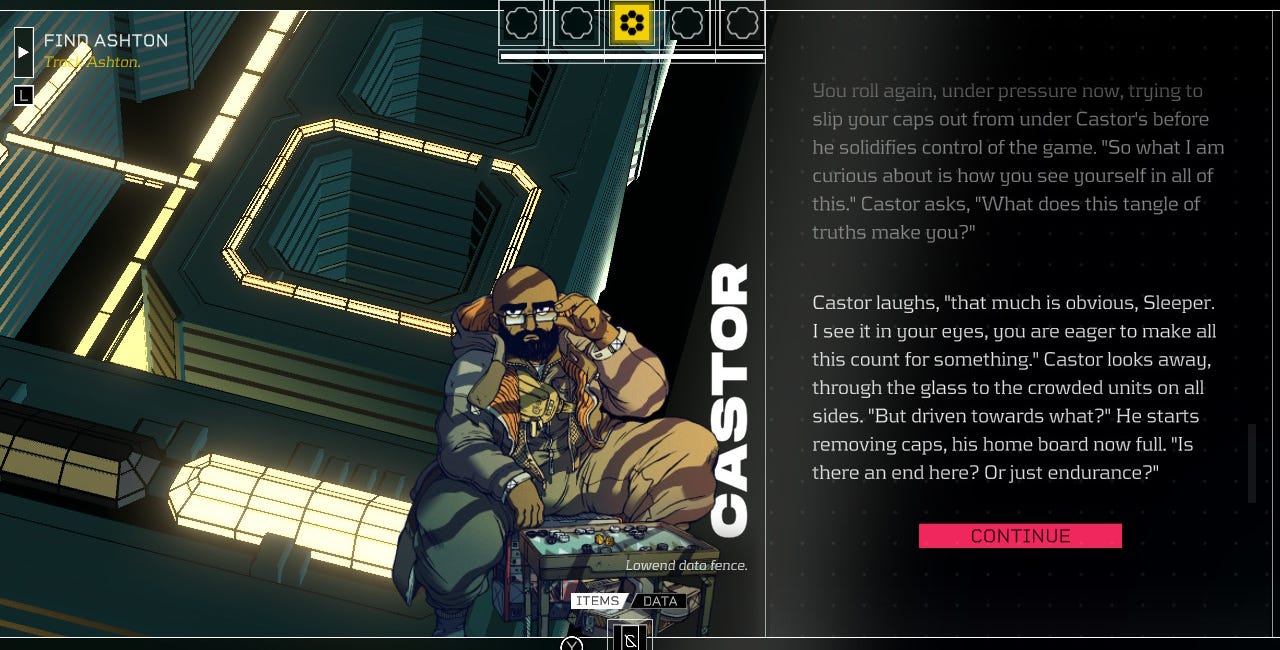The Wondrous Naïveté of Clair Obscur: Expedition 33
Clair Obscur: Expedition 33 is an impossible game made real, and inspired me to seek the impossible, too.
I thought I was about to lose my undefeated streak at the first boss of Clair Obscur: Expedition 33. Eveque, the shadowy woodland monster, had begun charging an attack two turns prior and as a lifelong Gamer I knew I had to end this fight before that attack went off. On each of the turns it charged, it clutched at its glowing weak point in the center of its chest, and the camera gives clear focus to the beautiful purple flowers blooming along each arm. I anticipated I had one last shot to end this.
The turn order is displayed to the left of the combat screen a la Final Fantasy X, and I could see both of my party members, Gustav and Lune, would attack next. I had no more charges left to fire off my more powerful special attacks, but with the minuscule amount of health Eveque had left, I wasn’t worried. Gustav’s regular attack chunked off more than half the remaining health as expected and I was home free. I selected Lune’s regular attack, and as she pulled off a levitating spinning back kick, my heart dropped as the boss’s health bar didn’t budge.
I mentioned before I’ve been doing this a long time (Gaming) so a few things ran through my head as it seemed the boss would be eviscerating my team any moment. There is a common trope of the unbeatable first boss in games meant to be a tutorial or indication of challenges to come. The second thought was that players are meant to see the climactic boss attack, and it would trigger inevitably when the boss’s health reached a certain threshold. Finally, it was possible Lune’s regular attack, which I had not put a single attribute point into, was just not very strong and we were about to die. None of these were the case.
The scene cuts to an in-engine1 cinematic in which the boss looks to be readying its final blow. Lune calls to Gustav, hovering in the air with her mage powers. Together they spot an opening, and strike in a climactic flurry, ending the boss fight.
This is not necessarily a unique concept. It’s most popular instance being in the question, “how do you want to do this,” asked by Matt Mercer in the popular tabletop RPG performance Critical Role— you’ve struck the finishing blow, get creative and describe how it looks. Seeing it in a video game is less common. I lit up when I realized what was happening and it brought me back to a thought and mindset I had when I was a child but had since been suppressed by mundane, cruel “reality.”
Tell me if any of these sound familiar:
“If I got to make a movie, I would hire all the biggest actors and write the best script and tell everyone in the world about how good it was.”
“If I wrote a book it would be every genre at once with action and romance and drama and it’s gonna be a trilogy and a movie and everyone will love it.”
“If I could make a game, it would remind you of the best Final Fantasy combat, but also it’s like Dark Souls, and the actors are all from recent hit video games, and Marvel, and Lord of the Rings movies, and when you beat a boss, a cinematic plays that shows your character’s epic victory!”
These are the childish ramblings of the inexperienced creative, naive to the constraints of how art is funded, who and how many people are involved, deadlines, mandates, budgets, market trends, the three act structure, etc. The older we get, the more we learn about these constraints, the more they become a forethought to creation. While constraints can be a boon to the creative process, these in particular, the corporate funded “reality,” loom over the creative like shadows, obscuring possibility.
“…they still were able to include flashy attack animations complete with dramatic final blow cinematics for tough boss fights, a cinematic that made me want to seek my own childlike creativity again. I wanted to create without rules or pretenses of what was possible.”
Clair Obscur: Expedition 33 seems to disprove this reality. An independent game studio, Sandfall Interactive, made up of just over 30 talented game developers, with their first game, scribbled their childhood dreams and ambitions on a piece of construction paper and brought it to life. Some of the biggest names in video game voice acting are here fresh off of huge successes like Baldur’s Gate 3 and Final Fantasy XVI. The lead, Gustav is voiced by Charlie Cox who can be seen as the titular character in the latest season of Marvel’s Daredevil. Of course, the incredible Andy Serkis also lends his voice to the project. This is, by all accounts, a dream cast for a small studio’s first project.
Developed using Unreal Engine 5, the game is beautiful and runs near flawlessly on all platforms, a feat studios like Ubisoft, Bethesda, even FromSoftware, are still working to pull off. The art direction is unique and some areas are truly breathtaking to look at. One area in particular has you enter into an underwater environment, yet the player simply walks through it surrounded by the sea life.
Ambitious and successful as this all is this is video games we’re talking about, and none of it matters without fun and satisfying moment to moment gameplay. Once again Sandfall Interactive took all of their favorite parts of every iconic RPG and smashed it into a supergroup game. Turn based combat by way of Final Fantasy X allows for clever strategy while mixing in a dodge and parry system to keep the player engaged during the enemy’s turn. There are a plethora of upgrades and equipables to customize the builds of your party members that can be used for role play purposes (my preferred play style) or min maxed2 to the point of absolute domination over every opponent. All of this, and they still were able to include flashy attack animations complete with dramatic final blow cinematics for tough boss fights, a cinematic that made me want to seek my own childlike creativity again. I wanted to create without rules or pretenses of what was possible. Everything I’ve just described about this game should be impossible, yet here we are.
I wrote about how turn based combat is best for story telling and player imagination here
How to Play Citizen Sleeper: Imagination & Player Freedom
This analysis of Citizen Sleeper includes a custom challenge run I created for myself. For a list of basic rules and suggestions for trying it out for yourself, skip to the bottom of the page!
Strategic partnerships and clever capital acquisition helped Sandfall Interactive bring their vision to life, including a grant from Epic Games created specifically to help smaller teams get up and running. Clair Obscur also released day one on Game Pass, Microsoft’s game streaming platform, and Sandfall have developed some level of partnership with the tech giant having been featured in several showcases and developer directs. Early in production, they received financial support from local government funds including the French National Center for Cinema and another local fund for developing in the Occitanie region.
Ultimately, it’s clear this small team has created something special against all preconceived notions of the possible. In a world and industry where layoffs and downscaling plague even the titans of gaming, like Sony and Microsoft, somehow this new (though experienced) team managed to break through “reality.” Clair Obscur then manages something beyond just a great game. It reminds us of what creativity and art are all about: imagining the impossible. Both in the art, and in our world.
The scene is running using the engine that runs normal gameplay so it is consistent with the graphics and framerate of the game as you are playing it, as opposed to a pre-rendered cutscene where visuals may be of a higher fidelity.
A playstyle in which players choose equipment, abilities, upgrades, etc. to optimize their characters, minimizing weaknesses and maximizing strengths.






Yes! Yes! Yes! It really evokes such a childlike wonderment. I am either playing the game or thinking about the game. Great spirited take